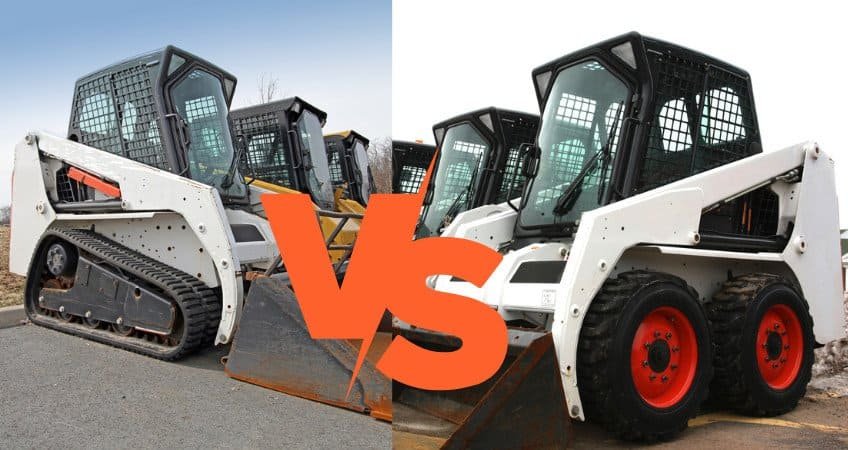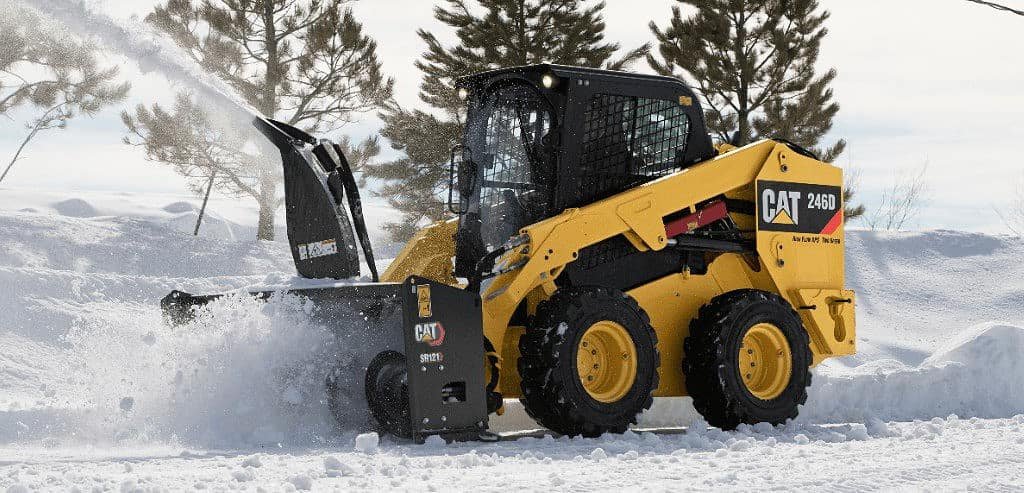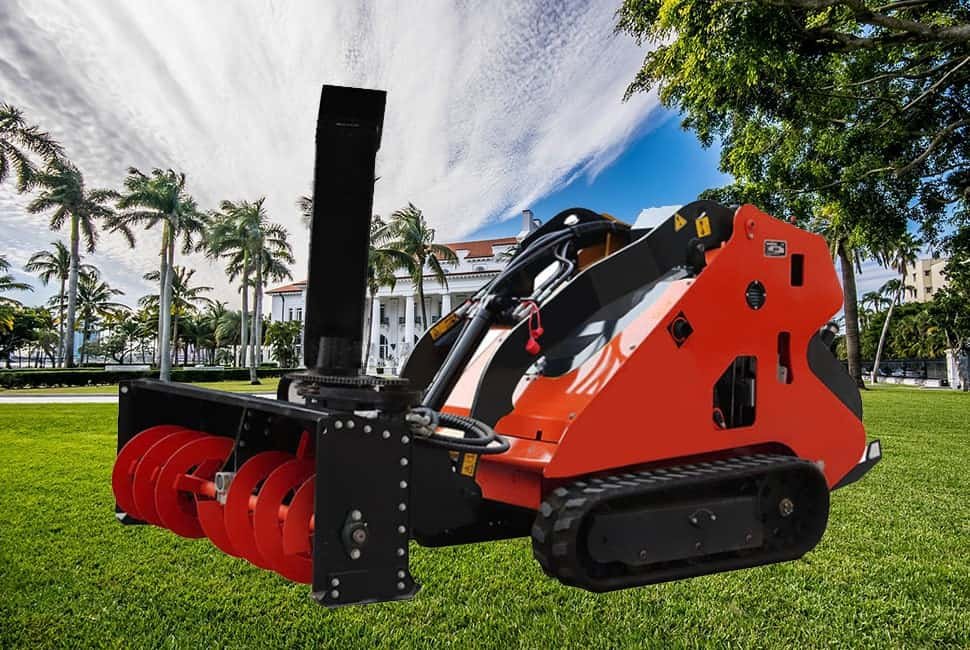When choosing a skid steer for your project, deciding between track or wheeled models can be a challenging task. Let’s dive into the advantages and specific use cases of each type to help you make an informed decision.
Track vs wheeled skid steer each have their own set of advantages. Tracks are ideal for uneven terrain, offering better traction, while wheels are better suited for flat roads and faster speeds. This guide will help you determine the best option for your needs.
Keep reading to explore the key differences between track and wheeled skid steers, and learn which one is the right fit for your project.
ما هو انزلاقية التوجيه؟
A skid steer is a versatile piece of construction equipment widely used in industries like construction, agriculture, and land management. It can be equipped with a variety of attachments to perform tasks such as digging, lifting, and clearing.
Skid steers are compact, highly maneuverable machines that can be driven by either tracks or wheels. They are an excellent choice for tight spaces and projects requiring flexibility. Both track and wheeled models offer distinct performance characteristics.
The defining feature of skid steers is their exceptional turning radius and ability to operate in confined spaces. This makes them ideal for construction sites, farms, and other areas with limited maneuvering room. The choice of tracks or wheels affects their performance in different conditions, from soft ground to hard, flat surfaces.
Track vs Wheeled Skid Steer: The Basic Differences
When considering the purchase or rental of skid steers, it’s essential to understand that the core distinction between track and wheeled models is rooted in their drive systems. These systems not only dictate how each type of skid steer operates but also how they perform in a variety of environments. Making the right choice can be a game-changer for your project’s productivity and efficiency.
Track Skid Steers: Unmatched Performance on Unstable Terrain
Track skid steers truly shine when it comes to navigating soft, uneven, or slippery terrains. Their design ensures enhanced traction and stability, which is a result of the larger surface area of the tracks in contact with the ground. This feature is particularly beneficial in conditions where wheeled skid steers might struggle, such as on muddy or rocky surfaces. The tracks spread the machine’s weight more evenly, significantly reducing the likelihood of the skid steer becoming bogged down or stuck.
Wheeled Skid Steers: The Speedy Option for Flat Terrain
In contrast, wheeled skid steers are designed to excel on hard, flat surfaces where speed and agility are crucial. Their compact wheels allow for rapid movement and swift turns, which is ideal for tasks that require quick navigation and execution. Moreover, wheeled skid steers are generally easier to handle and maintain, with lower maintenance costs due to their resistance to damage from sharp objects and their suitability for smooth surfaces.

Deciphering the Differences for Optimal Machine Selection
Grasp the nuances between track and wheeled skid steers to make an informed decision tailored to your specific project needs. Track skid steers are the champions of challenging landscapes, with their ability to maintain grip and stability even when the ground is wet or soft. They are the preferred choice for jobs that require traversing rough or unpredictable terrains.
On the flip side, wheeled skid steers are the champions of speed and efficiency on solid ground. They offer a cost-effective solution for projects that benefit from quick operations and lower long-term maintenance expenses. Their nimbleness and speed on firm, smooth surfaces make them a popular choice for construction sites and landscaping tasks that demand rapid progress.
In conclusion, the decision to opt for a track or wheeled skid steer should be based on a thorough evaluation of your project’s terrain and requirements. By considering the unique advantages of each type, you can select the skid steer that will not only meet but exceed your expectations, ensuring a smooth and efficient workflow.
Advantages of Track Skid Steers
Track skid steers provide excellent performance in harsh environments, particularly on rough or uneven terrains. Their design allows them to distribute weight evenly, minimizing ground pressure and increasing stability.
Track skid steers are ideal for soft, muddy, or snowy terrain, offering superior traction and reducing the risk of getting stuck. This makes them a popular choice for construction projects in challenging conditions.
Track skid steers are built to handle heavy loads and provide superior stability in difficult conditions. Their wide tracks distribute weight across a larger surface area, allowing them to move easily through soft ground, snow, and sand. These machines are also less likely to cause damage to delicate or landscaped areas due to their lower ground pressure.
Advantages of Wheeled Skid Steers
Wheeled skid steers are highly efficient on flat, solid surfaces. They are faster and generally easier to maintain than their tracked counterparts, making them a cost-effective choice for certain applications.
Wheeled skid steers are faster and more efficient on hard surfaces. They require less maintenance and have a lower initial cost, making them ideal for projects on flat, paved ground or areas with firm footing.
Wheeled skid steers are perfect for tasks that require speed and agility, such as transportation and material handling. Their higher top speeds and ability to pivot on a dime make them ideal for urban environments and paved construction sites. They are also easier to repair and maintain, as the tires can be replaced relatively quickly.
Track or Wheel Skid Steer for Farm Use?
When it comes to farm work, choosing between a track or wheeled skid steer depends on the type of land and the specific tasks at hand. Both types have advantages based on soil conditions and farm requirements.

Track skid steers are often preferred for farming tasks that involve wet or soft soil, as the tracks distribute the weight evenly, preventing the machine from sinking. Wheeled skid steers perform well on firmer, level ground and are better for tasks requiring speed.
For farm work, a track skid steer is often the better choice for handling wet, muddy, or uneven ground conditions. Tracks offer better flotation and can handle heavier loads without causing damage to the soil. However, if your farm has primarily flat, firm land, a wheeled skid steer may provide faster travel times and lower operating costs.
Snowblower Tracks vs Wheels: Which is Better for Snow Removal?
Snow removal is a task that requires precision, power, and the right equipment to tackle Mother Nature’s winter challenges effectively. The decision between a tracked or wheeled skid steer is pivotal in determining the success of your snow-clearing operations, and it largely hinges on the characteristics of the snow and the terrain you’re dealing with.
Track Skid Steers: The Heavyweights of Snow Clearance
When faced with deep, heavy snow or treacherous icy conditions, tracked skid steers emerge as the superior choice. Their design provides an increased surface area in contact with the ground, which minimizes the risk of the machine becoming bogged down in the snow. This feature is particularly advantageous in situations where wheeled skid steers might falter. Tracked skid steers also boast enhanced stability on sloped or uneven terrains, making them indispensable for navigating through snow-covered hills and irregular landscapes.
Wheeled Skid Steers: Swift and Efficient on Hard Surfaces
Conversely, wheeled skid steers excel in scenarios where light snowfall or the need to clear compacted snow from hard, paved surfaces is the primary concern. Their agility and speed on these surfaces make them the go-to option for quick and efficient snow removal tasks. Wheeled skid steers are also more maneuverable, allowing for precision work in tight spaces and around obstacles that might be present on urban or residential snow removal jobs.

Deciphering the Performance in Snowy Conditions
To make the most informed decision for your snow removal needs, it’s crucial to understand how each type of skid steer performs in various snow conditions. Tracked skid steers are the champions of heavy-duty snow removal, providing the necessary traction and stability to power through deep snow without getting stuck. They are the workhorses for challenging winter weather, ensuring that you can maintain progress even in the most demanding conditions.
On the other hand, wheeled skid steers are the speedsters of the snow removal world, designed for rapid response to lighter snowfalls and the efficient clearing of compacted snow on solid surfaces. Their nimbleness and ease of use make them perfect for urban environments where speed and precision are key.
In summary, the choice between a tracked or wheeled skid steer for snow removal should be guided by the specific snow and terrain conditions you expect to encounter. By considering the unique strengths of each, you can equip yourself with the ideal machinery to conquer winter’s challenges and keep your pathways clear and safe.
Comparing Speed, Power, and Other Characteristics of Track vs Wheeled Skid Steers
Speed, power, and other performance metrics differ significantly between track and wheeled skid steers. Knowing how each type performs in these areas can help you choose the right equipment for your project.
Wheeled skid steers typically offer higher speeds and better fuel efficiency on hard surfaces, while track skid steers provide superior traction and power in rough, challenging terrains. Each machine excels in different areas based on the project needs.
Wheeled skid steers tend to have a faster top speed, making them ideal for tasks that require quick movement over hard surfaces. They also offer better fuel efficiency on flat, solid ground. However, track skid steers deliver more power and traction, making them the go-to option for tough terrain, snow, and construction work in challenging environments.
ملخص
Track and wheeled skid steers each have their unique advantages. The right choice depends on your project’s environment, speed requirements, and terrain conditions. Make sure to choose the machine that best suits your specific needs.


